Related Research Articles
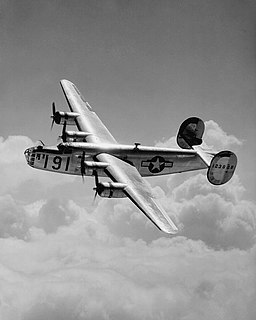
The Consolidated B-24 Liberator is an American heavy bomber, designed by Consolidated Aircraft of San Diego, California. It was known within the company as the Model 32, and some initial production aircraft were laid down as export models designated as various LB-30s, in the Land Bomber design category.
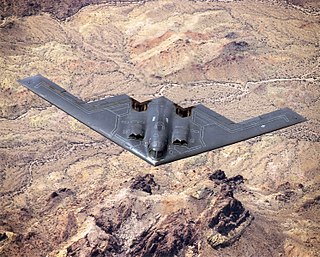
A flying wing is a tailless fixed-wing aircraft that has no definite fuselage, with its crew, payload, fuel, and equipment housed inside the main wing structure. A flying wing may have various small protuberances such as pods, nacelles, blisters, booms, or vertical stabilizers.

The Martin B-26 Marauder is an American twin-engined medium bomber that saw extensive service during World War II. The B-26 was built at two locations: Baltimore, Maryland, and Omaha, Nebraska, by the Glenn L. Martin Company.

The Northrop P-61 Black Widow, named for the North American spider, was the first operational U.S. warplane designed as a night fighter, and the first aircraft designed to use radar. The P-61 had a crew of three: pilot, gunner, and radar operator. It was armed with four 20 mm (.79 in) Hispano M2 forward-firing cannon mounted in the lower fuselage, and four .50 in (12.7 mm) M2 Browning machine guns mounted in a remote-controlled dorsal gun turret.

The Northrop F-89 Scorpion was an American all-weather, twin-engined interceptor aircraft built during the 1950s, the first jet-powered aircraft designed for that role from the outset to enter service. Though its straight wings limited its performance, it was among the first United States Air Force (USAF) jet fighters equipped with guided missiles and notably the first combat aircraft armed with air-to-air nuclear weapons.

The Convair YB-60 was an American prototype bomber aircraft for the United States Air Force, canceled on 14 August 1952.

The Douglas XTB2D Skypirate was a torpedo bomber intended for service with the United States Navy's Midway- and Essex-class aircraft carriers; it was too large for earlier decks. Two prototypes were completed, but the dedicated torpedo bomber was becoming an outdated concept, and with the end of World War II, the type was deemed unnecessary and cancelled.

The Douglas XB-42 Mixmaster was an experimental bomber aircraft, designed for a high top speed. The unconventional approach was to mount the two engines within the fuselage driving a pair of contra-rotating propellers mounted at the tail in a pusher configuration, leaving the wing and fuselage clean and free of drag-inducing protrusions.
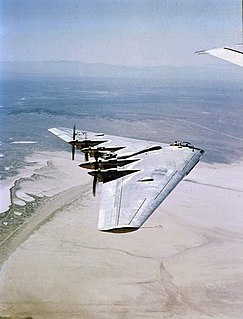
The Northrop XB-35 and YB-35, Northrop designation N-9 or NS-9, were experimental heavy bomber aircraft developed by the Northrop Corporation for the United States Army Air Forces during and shortly after World War II. The airplane used the radical and potentially very efficient flying wing design, in which the tail section and fuselage are eliminated and all payload is carried in a thick wing. Only prototypes and pre-production aircraft were built, although interest remained strong enough to warrant further development of the design as a jet bomber, under the designation YB-49.

The Northrop YB-49 was an American prototype jet-powered heavy bomber developed by Northrop Corporation shortly after World War II for service with the United States Air Force. The YB-49 featured a flying wing design and was a turbojet-powered development of the earlier, piston-engined Northrop XB-35 and YB-35. The two YB-49s actually built were both converted YB-35 test aircraft.
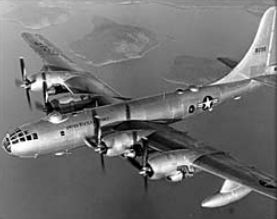
The Boeing B-50 Superfortress is an American strategic bomber. A post–World War II revision of the Boeing B-29 Superfortress, it was fitted with more powerful Pratt & Whitney R-4360 radial engines, stronger structure, a taller tail fin, and other improvements. It was the last piston-engined bomber built by Boeing for the United States Air Force, and was further refined into Boeing's final such design, the B-54. Not as well known as its direct predecessor, the B-50 was in USAF service for nearly 20 years.

The Curtiss-Wright XP-55 Ascender is a 1940s United States prototype fighter aircraft built by Curtiss-Wright. Along with the Vultee XP-54 and Northrop XP-56, it resulted from United States Army Air Corps proposal R-40C issued on 27 November 1939 for aircraft with improved performance, armament, and pilot visibility over existing fighters; it specifically allowed for unconventional aircraft designs. An unusual design for its time, it had a canard configuration, a rear-mounted engine, swept wings, and two vertical tails. Because of its pusher design, it was sarcastically referred to as the "Ass-ender". Like the XP-54, the Ascender was designed for the Pratt & Whitney X-1800 engine, but was re-designed after that engine project was canceled. It was also the first Curtiss fighter aircraft to use tricycle landing gear.
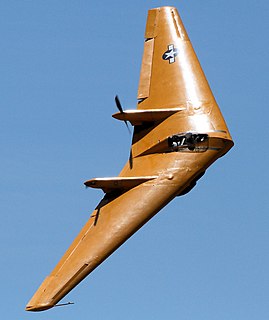
The Northrop N-9M was an approximately one-third scale, 60-ft span all-wing aircraft used for the development of the full size, 172-ft wingspan Northrop XB-35 and YB-35 flying wing long-range, heavy bomber. First flown in 1942, the N-9M was the third in a lineage of all-wing Northrop aircraft designs that began in 1929 when Jack Northrop succeeded in early experiments with his single pusher propeller, twin-tailed, twin-boom, all stressed metal skin Northrop X-216H monoplane, and a decade later, the dual-propeller N-1M of 1939–1941. Northrop's pioneering all-wing aircraft would lead Northrop Grumman many years later to eventually develop the advanced B-2 Spirit stealth bomber, which debuted in 1989 in US Air Force inventory.

The Consolidated XB-41 Liberator was a single Consolidated B-24D Liberator bomber, serial 41-11822, which was modified for the long-range escort role for U.S. Eighth Air Force bombing missions over Europe during World War II.

The Northrop N-1M, also known by the nickname "Jeep", was an American experimental aircraft used in the development of the flying wing concept by Northrop Aircraft during the 1940s.
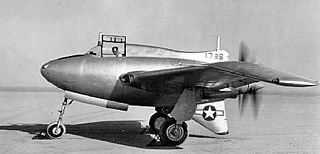
The Northrop XP-56 Black Bullet was a unique prototype fighter interceptor built by the Northrop Corporation. It was one of the most radical of the experimental aircraft built during World War II. Ultimately, it was unsuccessful and did not enter production.

The Horten H.XVIII was a proposed German World War II intercontinental bomber, designed by the Horten brothers. The unbuilt H.XVIII represented, in many respects, a scaled-up version of the Horten Ho 229, a prototype jet fighter. The H.XVIII was one of many proposed designs for an Amerikabomber, and would have carried sufficient fuel for transatlantic flights. The XVIIIA variant, with its wood structure, buried engines in the fuselage, flying wing design and carbon-based glue component, would have been, in theory, the first stealth bomber in history.

The Boeing YB-9 was the first all-metal monoplane bomber aircraft designed for the United States Army Air Corps. The YB-9 was an enlarged alteration of Boeing's Model 200 Monomail commercial transport.

The Vultee V-11 and V-12 were American stressed-skin monocoque monoplane attack aircraft of the 1930s. Developed from the Vultee V-1 single-engined airliner, the V-11 and V-12 were purchased by several nation for their armed forces, including China, who used them in combat against Japanese forces in the Second Sino-Japanese War. The United States Army Air Corps purchased seven V-11s as the YA-19 in the years before World War II, testing them to gather data to compare against twin engine light attack aircraft.
The Blohm & Voss P215 was an advanced jet night fighter project by Blohm & Voss during the Second World War. With a crew of three and twin jet engines, it featured a tailless swept-wing layout and heavy armament. An order for three prototypes was received just weeks before the war ended.
References
- 1 2 3 4 5 6 7 8 Chong, Anthony (2016-06-15). Flying Wings & Radical Things: Northrop's Secret Aerospace Projects & Concepts 1939-1994. Specialty Press. ISBN 978-1-58007-229-8.
- ↑ "Northrop N1M". National Air and Space Museum. Retrieved 2020-06-10.